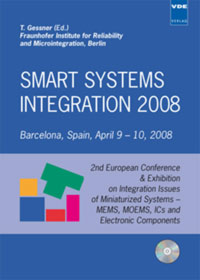Integrated planar low-cost sensor for reflection interference spectroscopy
Konferenz: Smart Systems Integration 2008 - 2nd European Conference & Exhibition on Integration Issues of Miniaturized Systems - MOMS, MOEMS, ICS and Electronic Components
09.04.2008 - 10.04.2008 in Barcelona, Spain
Tagungsband: Smart Systems Integration 2008
Seiten: 3Sprache: EnglischTyp: PDF
Persönliche VDE-Mitglieder erhalten auf diesen Artikel 10% Rabatt
Autoren:
Will, M.; Brodersen, O.; Steinke, A. (CIS Institute for Micro Sensors Erfurt)
Pröll, F.; Steinle, L.; Gauglitz, G. (Eberhard Karls University of Tuebingen)
Inhalt:
Measurement technologies based on changes of specific polymer layers are important in biotechnology and chemistry. Additional to surface plasmon resonance (SPR), the reflection interference spectroscopy (RIfS) is the most promising measuring technique for the characterization of changes of basic layer properties. Especially in the area of bio- and life-science one can see an increasing need for miniaturized detection systems. Special polymers optimized on thickness changes depending on concentration or existence of surrounding substances allow a wide spectrum of the detection applications. Potentials are in the area of measuring DNA interactions, characterization of antibodies, marking free detection of bimolecular interactions, supervision of fermentation processes, Freon detection, time dissolved detection of hydrocarbons and so on. In the area of the SPR, methods for the realizing of low cost sensors exists but there aren't any concepts for such sensors based on the RIfS yet. In this work we present a sensor concept, design and first results of a RIfS Sensor. Different model systems were examined by ray tracing simulations and verified in test experiments. The features of the planar structure of this type of the sensor and its differences in comparison with the classic RIfS are mentioned below. The potential and attainable specifications of a sensor show a compromise between measurement range and signal properties is given by the sensor design. The sensor parameters were found out quantitatively for the purpose of potential applications.


